There are few travel experiences that I love more than enjoying coffee in Italy.
Everything about the experience is delightful, from the predictably cool marble countertop to the fun of ordering coffee in Italy to the joy of that first sip of an Italian caffè in the morning.
Between the two of us, we have ordered somewhere in the neighborhood of a thousand shots of coffee in Italy, and along the way, we’ve learned quite a few things about how to order coffee in Italy!
If you’re planning a trip and want to pull off a seamless coffee shop (or more specifically, bar) experience from day one, here’s what to know about Italian coffee culture before you go.
Table of Contents
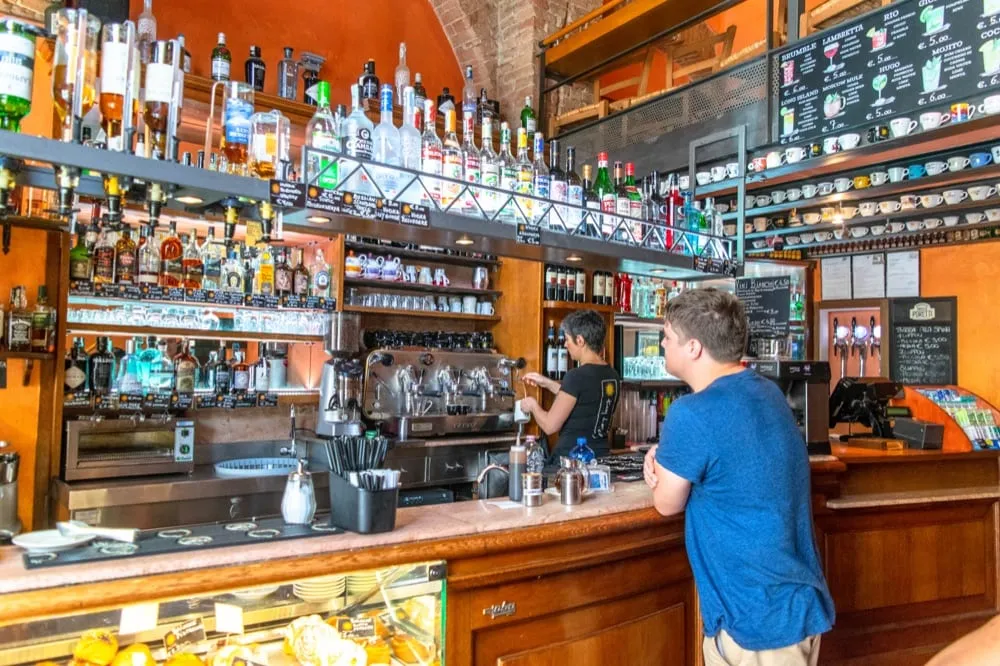
Where to Order Coffee in Italy
When looking for the best place to order coffee in Italy, look for a bar.
There are thousands upon thousands of bars in Italy, virtually all of which will feature a marble countertop, some kind of sign stating “bar” or sometimes “caffè” out front, a glass case for pastries/sandwiches, and a gigantic, well-loved espresso machine.
Bars in Italy are all-day affairs, and serve both coffee and alcohol throughout the day (though generally more coffee in the first half and alcohol in the second half, naturally).
Most restaurants will also have coffee on the menu, of course, but for the best coffee and the best cultural experience, head right to the bar.
The ubiquitous bar is the essential building block of Italian coffee culture–it all starts by stepping up to the counter.
Different Kinds of Italian Coffee to Enjoy
Navigating the different kinds of coffee you can order in Italy may seem a bit overwhelming at first, but ultimately it’s quite simple.
Every single coffee I’m going to outline here comes down to a few ingredients: coffee (what non-Italians think of as espresso), milk, and in 2 cases, alcohol or sugar.
That’s it.
No alternative kinds of milk, no alternative sweeteners, no sugary Starbucks-esque concoctions: in Italy, coffee is a more simplistic affair.
Over the years, plant-based milks have become slightly more available in major cities, but heavy emphasis on “slightly”.
Here are the kinds of coffee to be aware of when ordering coffee in Italy.
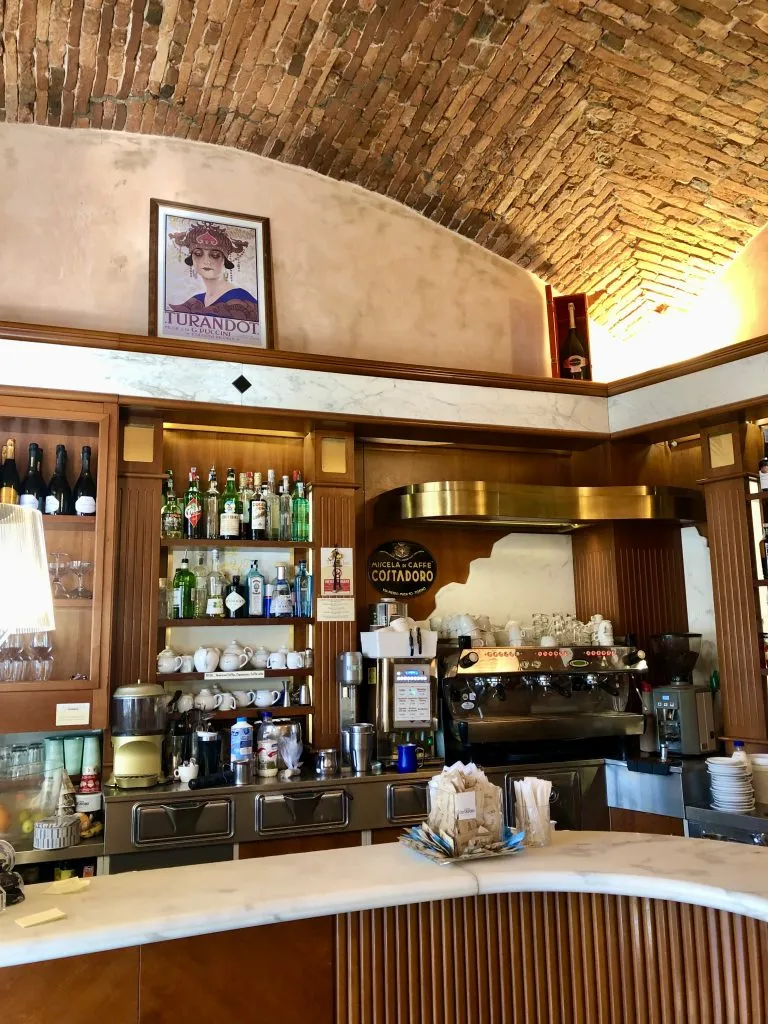
Caffè
“Un caffè” is the simplest and most popular coffee in Italy, and it’s what non-Italians would call a shot of espresso.
If you want to experiment with the most iconic option when drinking coffee in Italy–doing as the locals do, so to speak–un caffè is the drink for you.
If you order one, you may sometimes hear this repeated back to you by the bartender as “Un caffè normale?”.
This literally translates to “A normal coffee?” and figuratively translates to a good-natured, “Just to be clear, you know you’re not getting a giant cup of drip coffee, right?”.
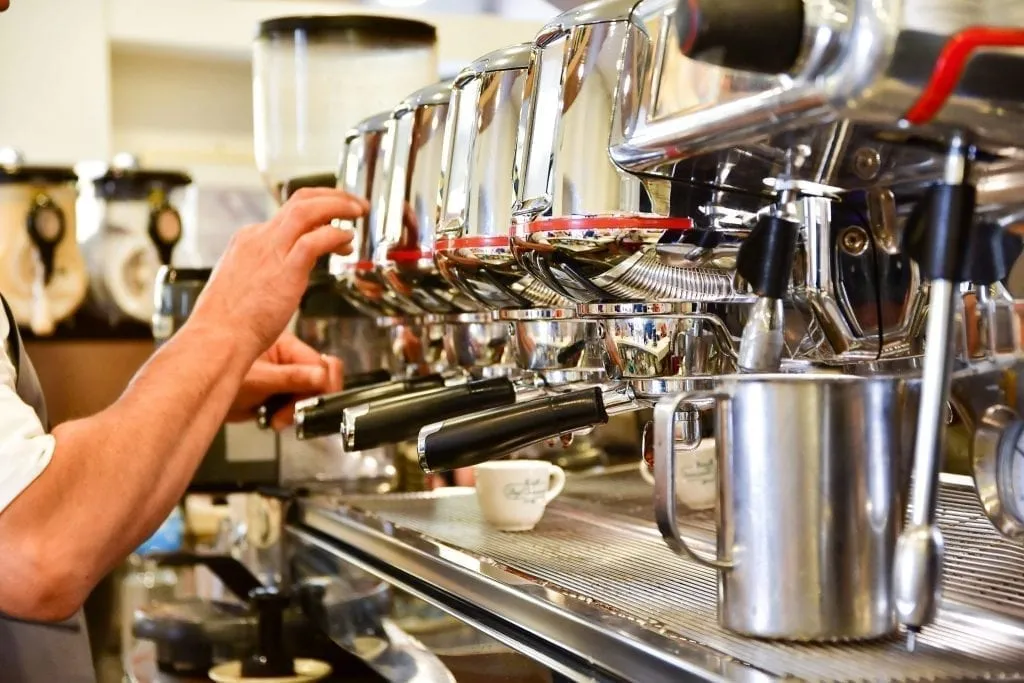
Caffè Doppio
A double shot of coffee.
Some say this is more for tourists, which may very well be true, but I can’t give it up and must confess I order them just about every morning that I’m in Italy.
The more Italian way to drink two shots of coffee, though, would simply be to order one caffè, drink it, and then ask for the second.
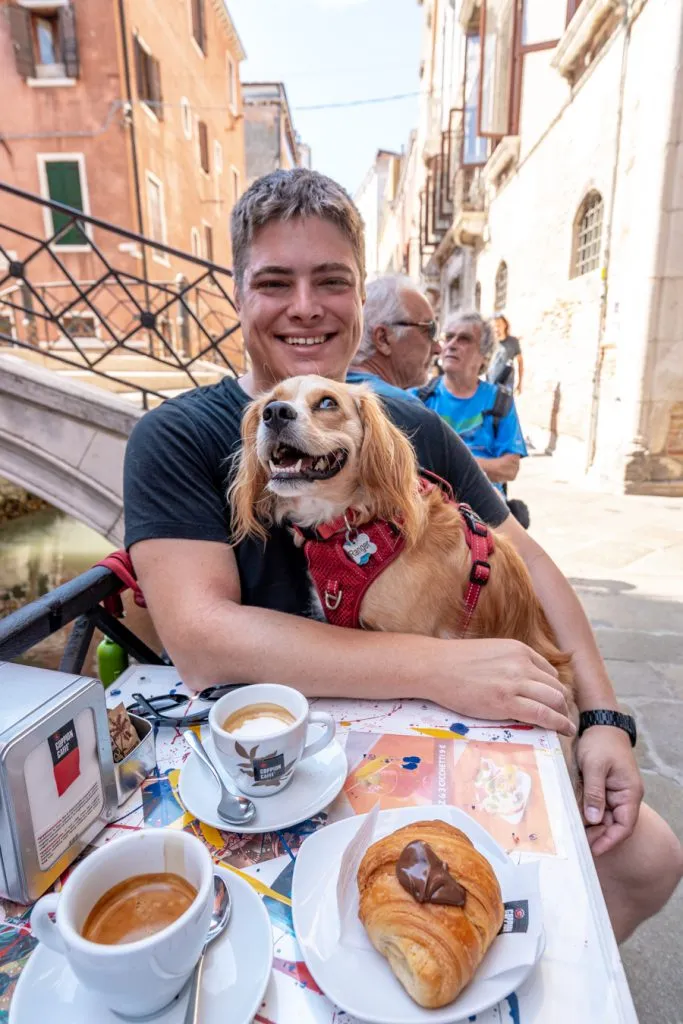
Caffè Lungo
A “long coffee” is the most similar coffee on this list in taste and feel to the filtered coffee that we Americans tend to drink at home, even more so than the infamous Americano (more on that one below).
Made by pulling a “long” espresso shot, a caffè lungo tends to have twice the volume of a caffè and a milder flavor as well.
A lungo can also take up to a minute to pull, making it one of the slower coffees to make in Italy.
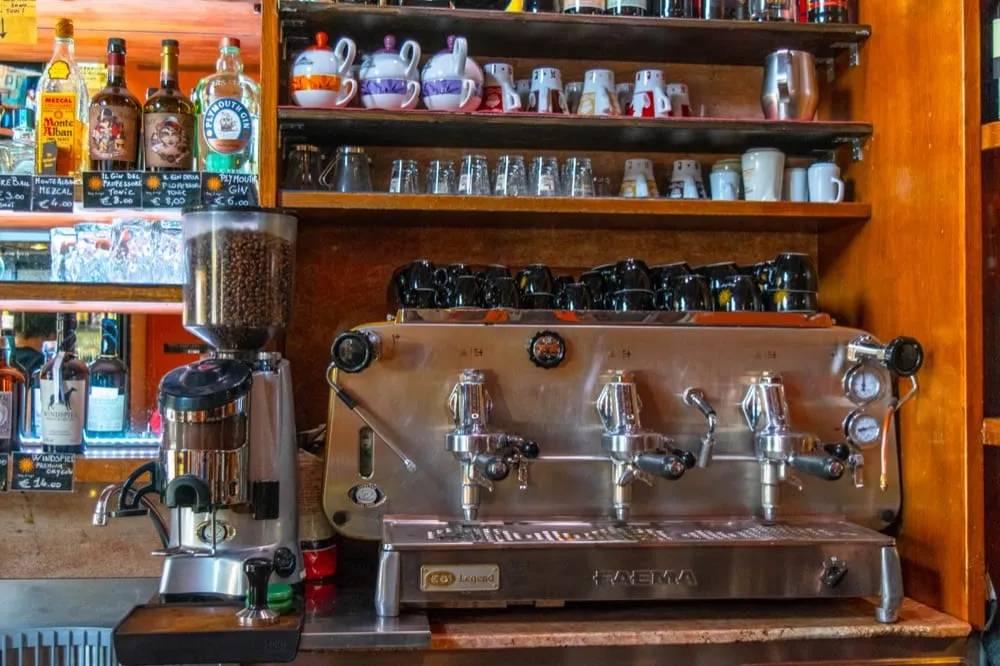
Caffè Corto (Or Ristretto)
The opposite of a caffè lungo, a caffè corto (or “short coffee”) has even less water than an average caffè and is the densest form of coffee in Italy.
Caffè Deca (Or Decaffeinato, Or Hag)
A shot of decaf.
I tend to order these a lot, as I like to enjoy a coffee after lunch and/or dinner in Italy but have a low caffeine tolerance.
While all of the phrases are technically correct for describing a shot of decaf, I’m in the habit of asking for a “caffè deca” and have never had an issue being understood by a waiter when asking for one.
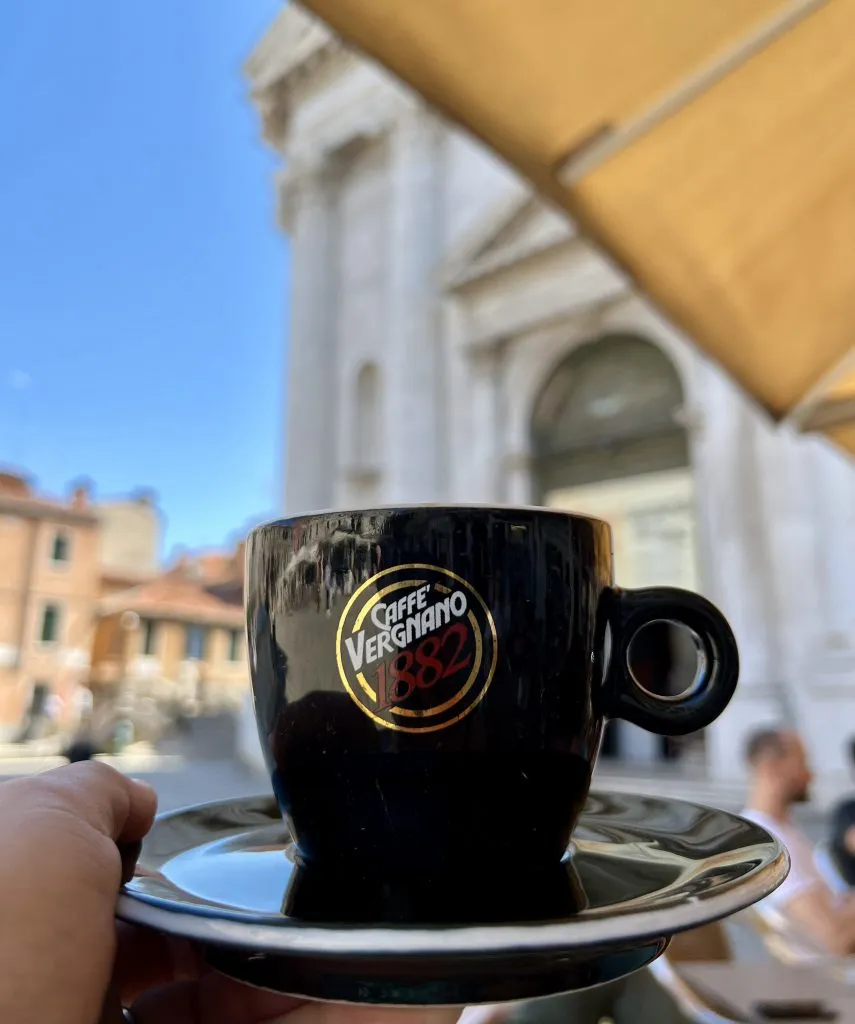
Cappuccino
A caffè cut with steamed milk and foam that is served in a small mug or cup that is larger than a tiny caffè cup but much smaller in volume than even a “small” coffee in the USA.
This is, of course, one of the most popular kinds of coffee to order in Italy.
It’s traditionally a breakfast drink, meant to be enjoyed first thing in the morning.
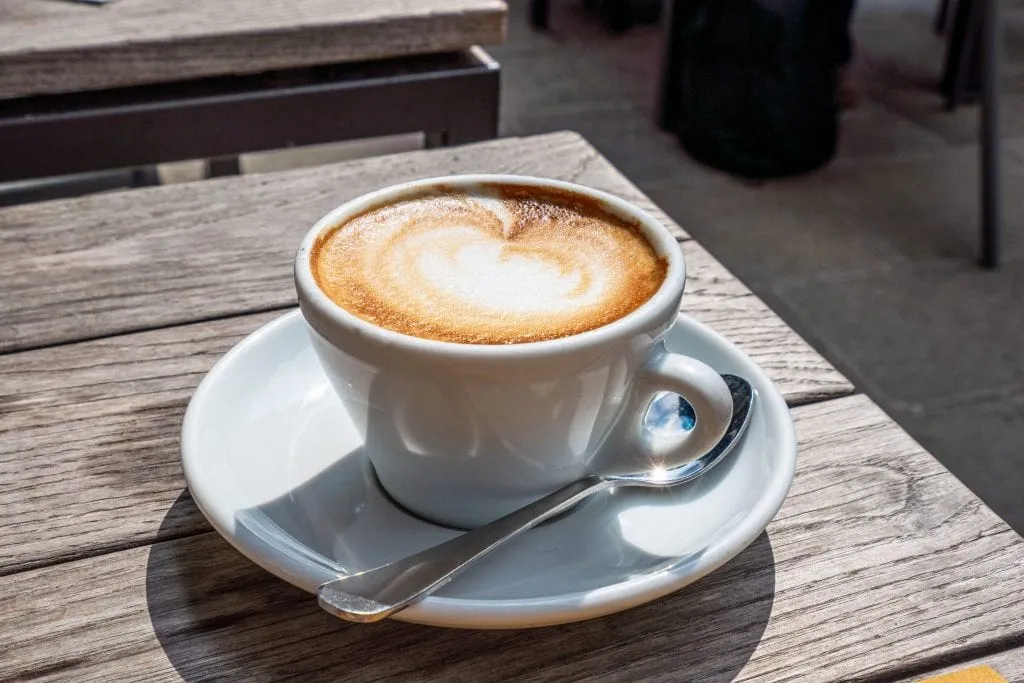
Americano
Indisputably the most touristy of all these drinks, you aren’t likely to walk into a bar and find an Italian drinking an Americano.
Made of a shot of coffee cut with hot water after it is pulled, I’m of the (admittedly biased) opinion that there’s no reason to ever order an Americano until you’ve at least tried more Italian coffees.
If a straight caffè is too much for you, consider trying a caffè lungo or one of the next few drinks listed below.
Caffè Latte
Coffee served with hot milk, generally served in a larger glass than even a cappuccino.
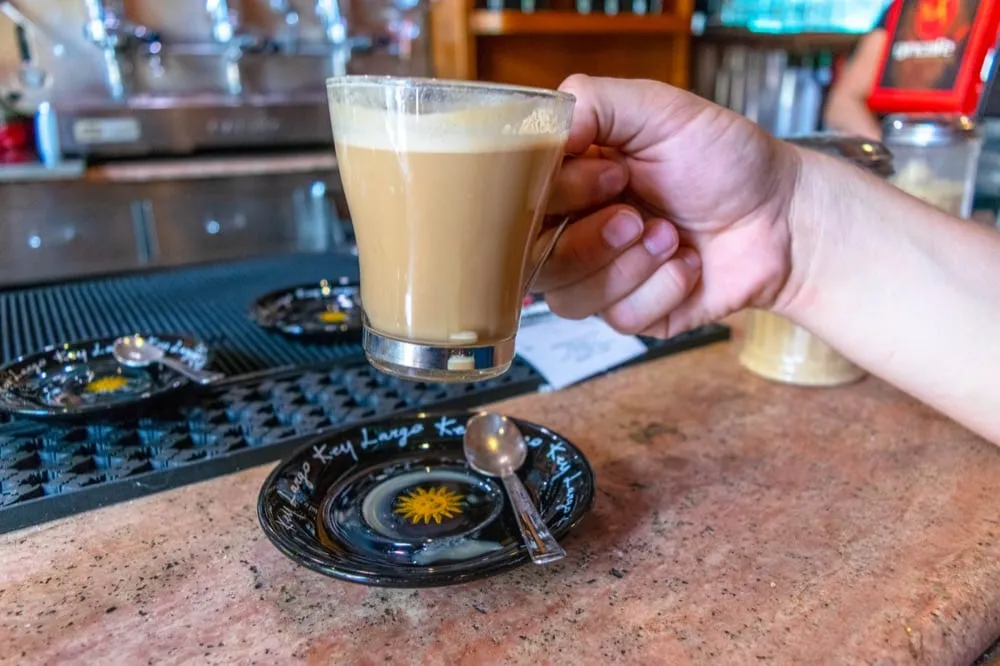
Caffè Macchiato
Translated as “coffee marked” or “coffee stained”, a caffè macchiato is a caffè “marked” with a dash of steamed milk.
This is a traditional Italian coffee with milk option outside of the breakfast hours, and Jeremy’s go-to coffee order in Italy!
Latte Macchiato
A latte macchiato is essentially the mirror image of a caffè macchiato: a shot of milk “marked” with a dash of coffee.
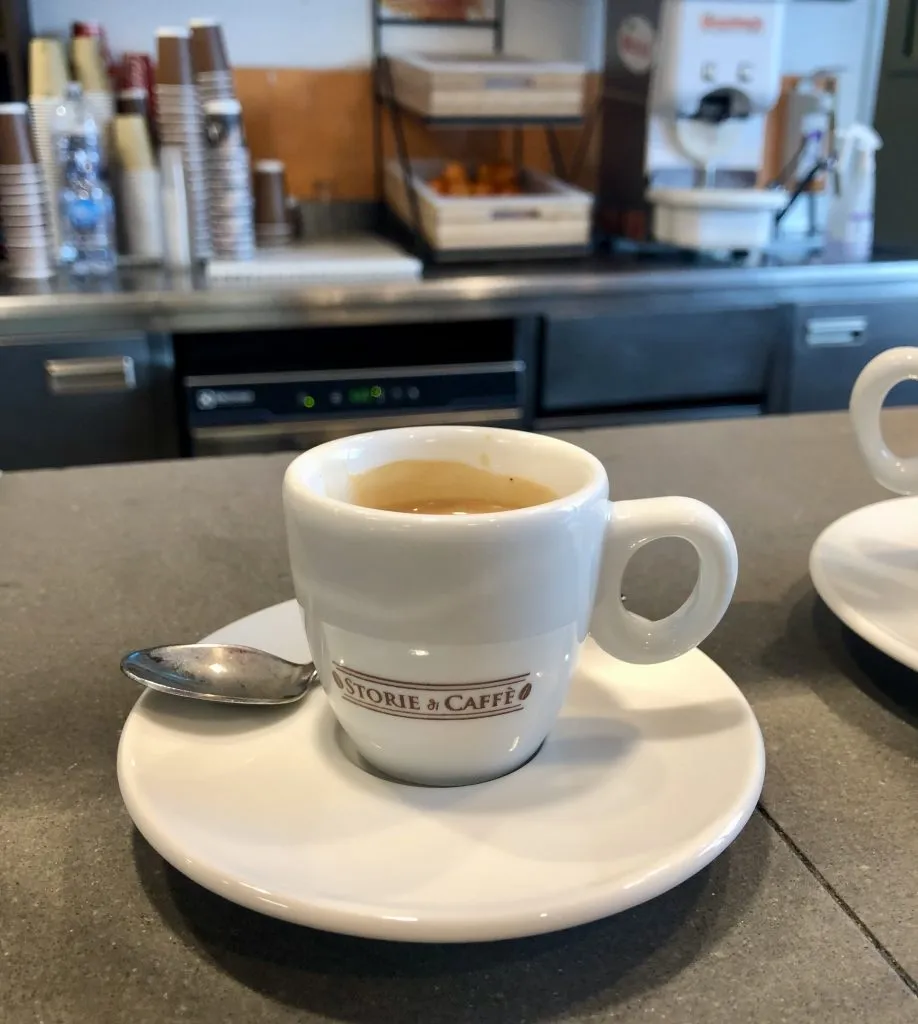
Caffè Corretto
Translated to “coffee corrected”, this is spiked coffee
It’s a single shot served with an additional shot of liquor, commonly grappa.
Caffè Con Panna
Want to combine coffee and dessert?
A caffè con panna is exactly that: a shot of espresso topped with a dollop of whipped cream.
They’re decadent and definitely worth trying once for breakfast!
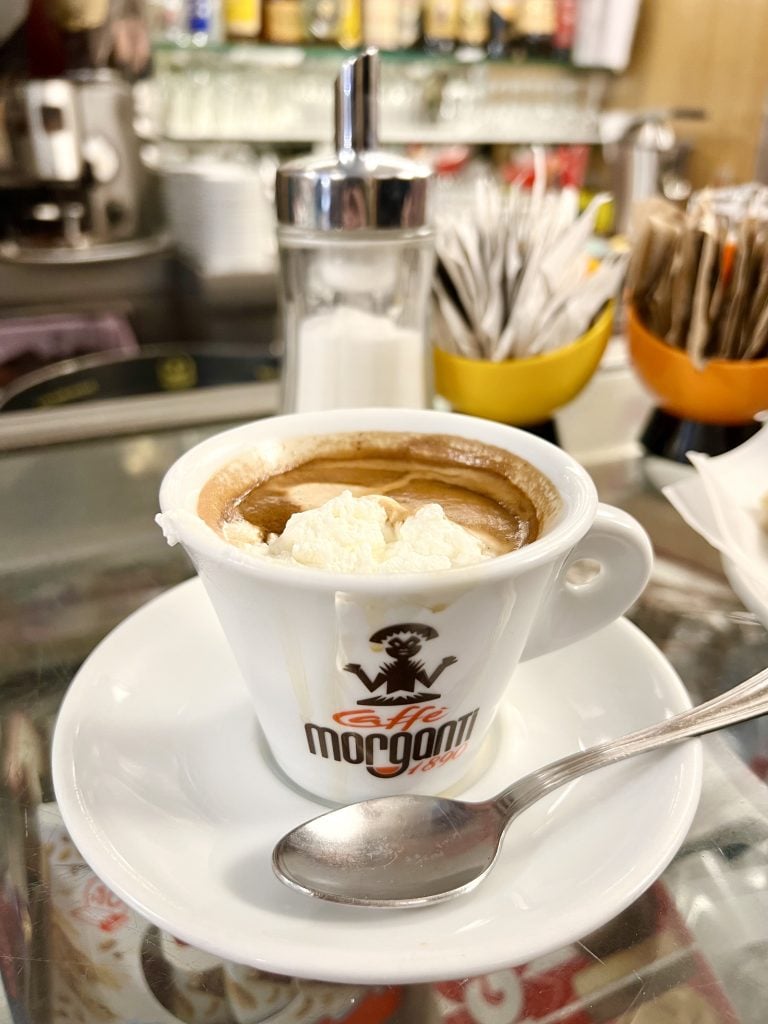
Cioccolata Calda
Not a coffee drinker but want to enjoy the coffee culture in Italy?
Try a hot chocolate–it’ll likely be the richest hot chocolate you’ve ever ordered in your life!
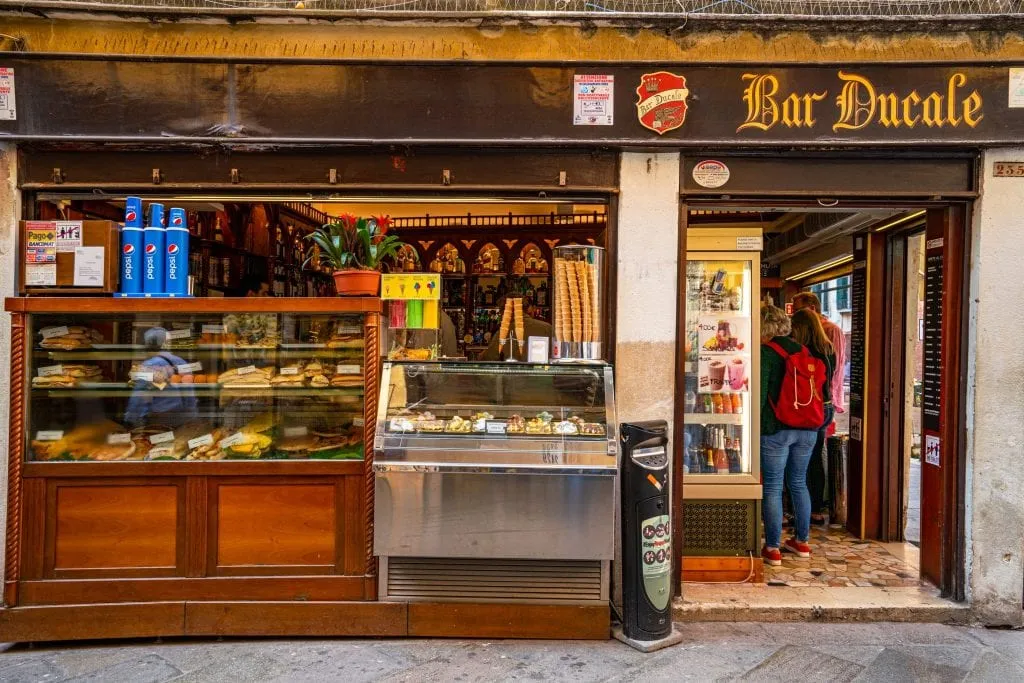
Caffè con Ghiaccio
Literally “coffee with ice”, a caffè con ghiaccio is a popular summer drink in Puglia, though you can order them all over Italy (and Jeremy definitely has).
Essentially, this is a shot of espresso with a cup of ice (by which I mean 2-3 cubes of ice) served on the side.
You can then pour the coffee over the ice, making your own Italian version of iced coffee.
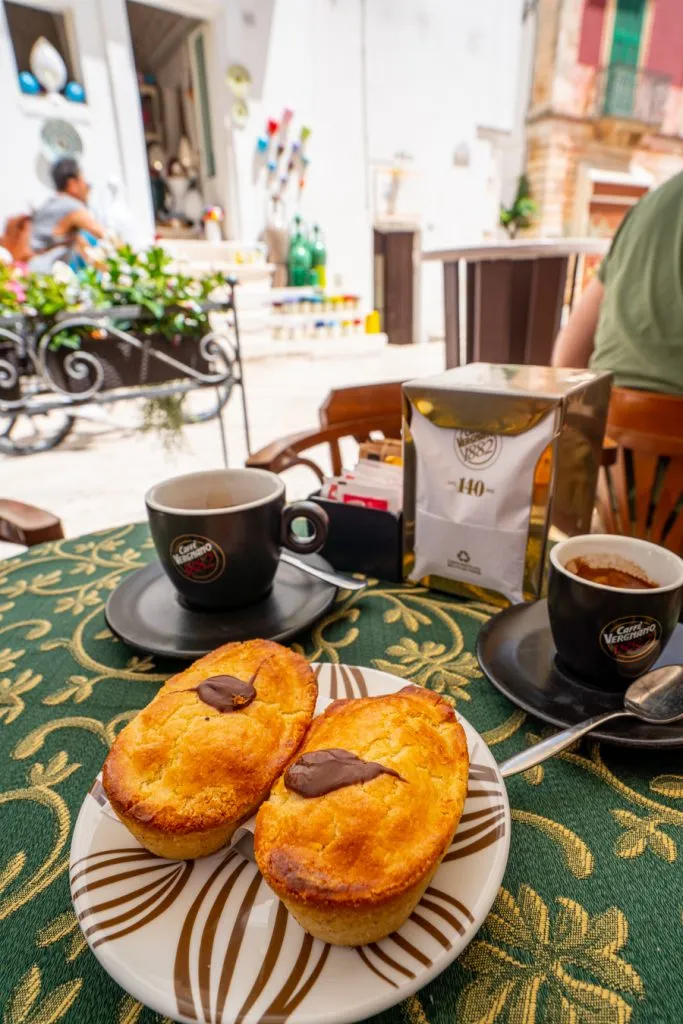
Caffè Shakerato
A somewhat fancier way to order cold coffee in Italy is to ask for a “caffè shakerato“.
This is espresso shaken up with ice and sugar, and often looks a little bit like a cocktail when served.
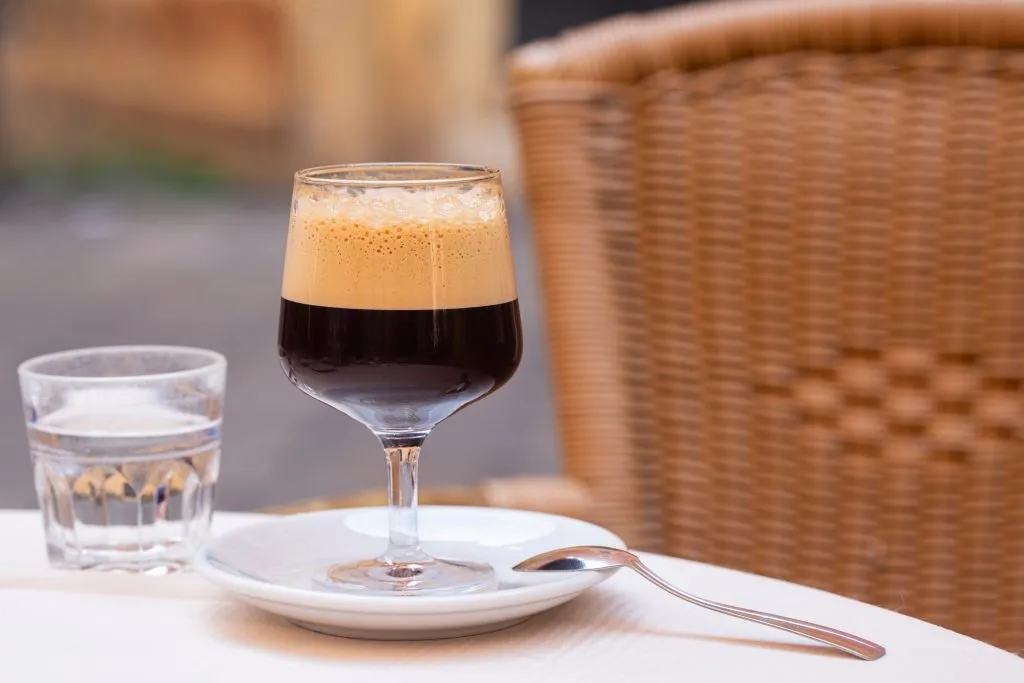
How to Order Coffee in Italy: Vocab Tips + Language
To order coffee in Italian, the only phrase you need is “Un caffè, per favore”, which translates as “A coffee, please.”
You can swap “un caffè” for any of the coffees listed above.
If you’d like to be more formal, you can expand into “Vorrei un caffè, per favore”, which is “I would like a coffee, please” in Italian–but that’s really way too formal for most bars and unnecessary.
We highly recommend trying to get comfortable ordering coffee in Italian during your trip.
It’s fairly simple to do, the bartenders are generally very nice about it, and since it’s something you’ll (probably) do repeatedly during your trip, you’ll be able to see your language skills improve in real time each day.
A few more Italian words and phrases you might like to use when ordering coffee in Italy include:
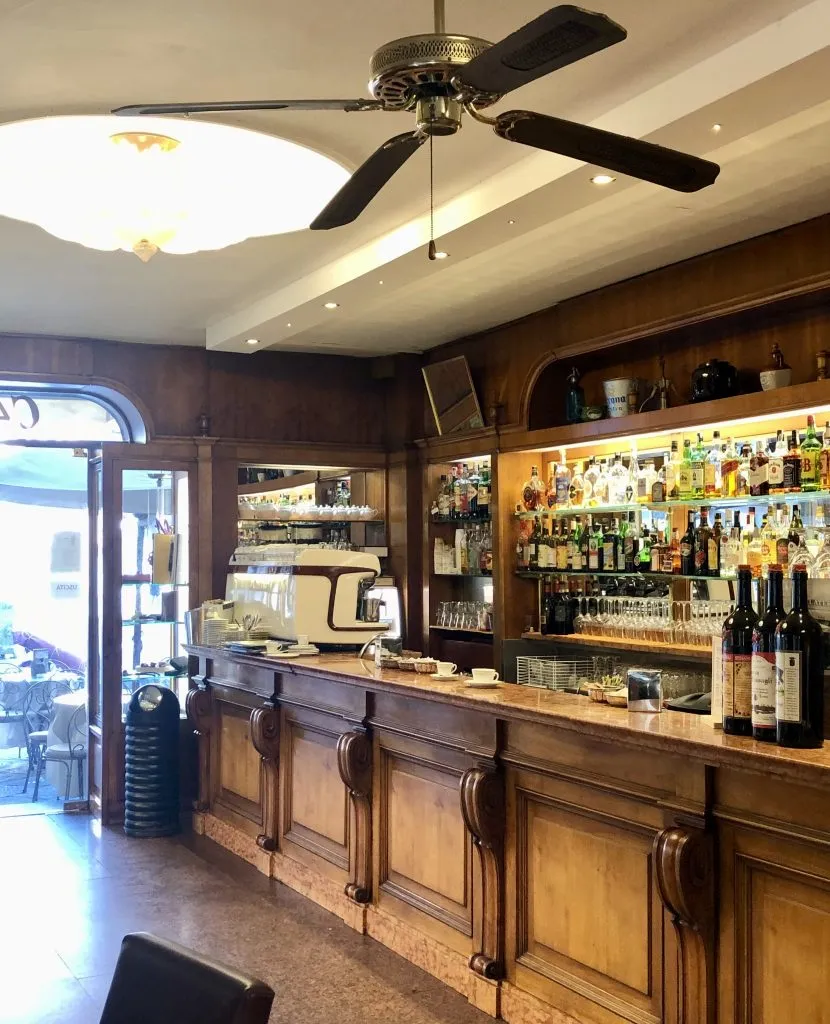
Buongiorno. — Good day.
Buonasera. — Good evening.
It’s always appreciated to start with a nice greeting and attempt some Italian right off the bat!
Grazie. — Thank you.
You can also use “grazie mille” for service above and beyond the norm.
Grazie mille translates literally as “a thousand thanks” and is used like “thank you so much”.
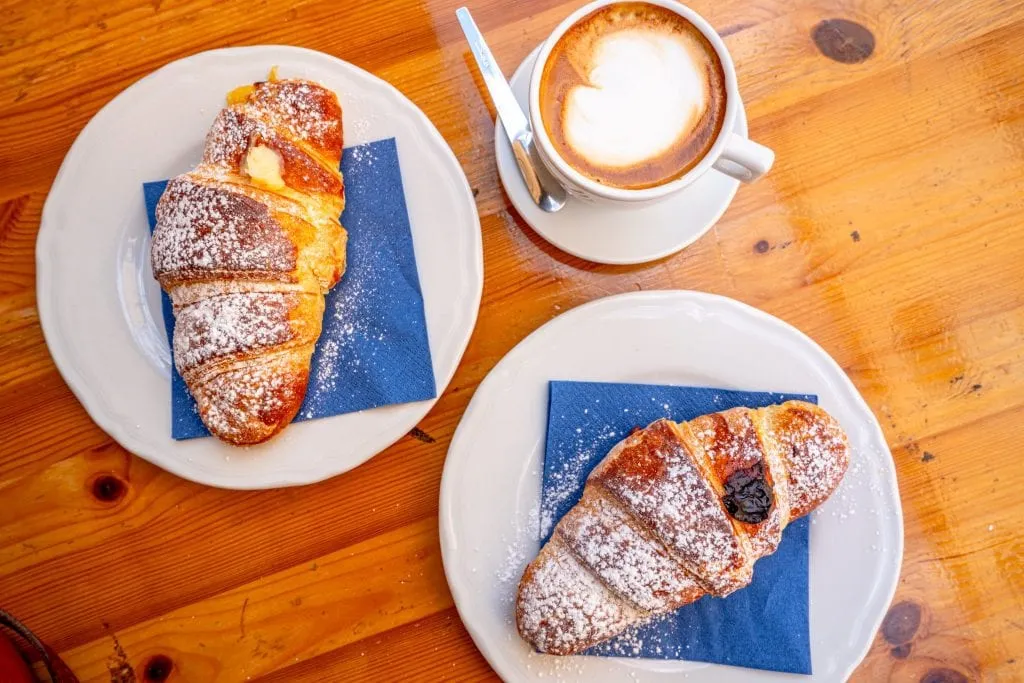
Uno, Due, Tre, Quattro, Cinque — One, Two, Three, Four, Five
Arrivederci. — See you later/Until we meet again
“Ciao” is a bit less formal than arrivederci and can be used as both hello and goodbye.
However, it’s generally best to feel out the formality of the bar first, and possibly save it for repeat visits.
Un bicchiere d’acqua, per favore. — A glass of water, please.
This will often be given automatically with your coffee, but you can always ask for it in a pinch!
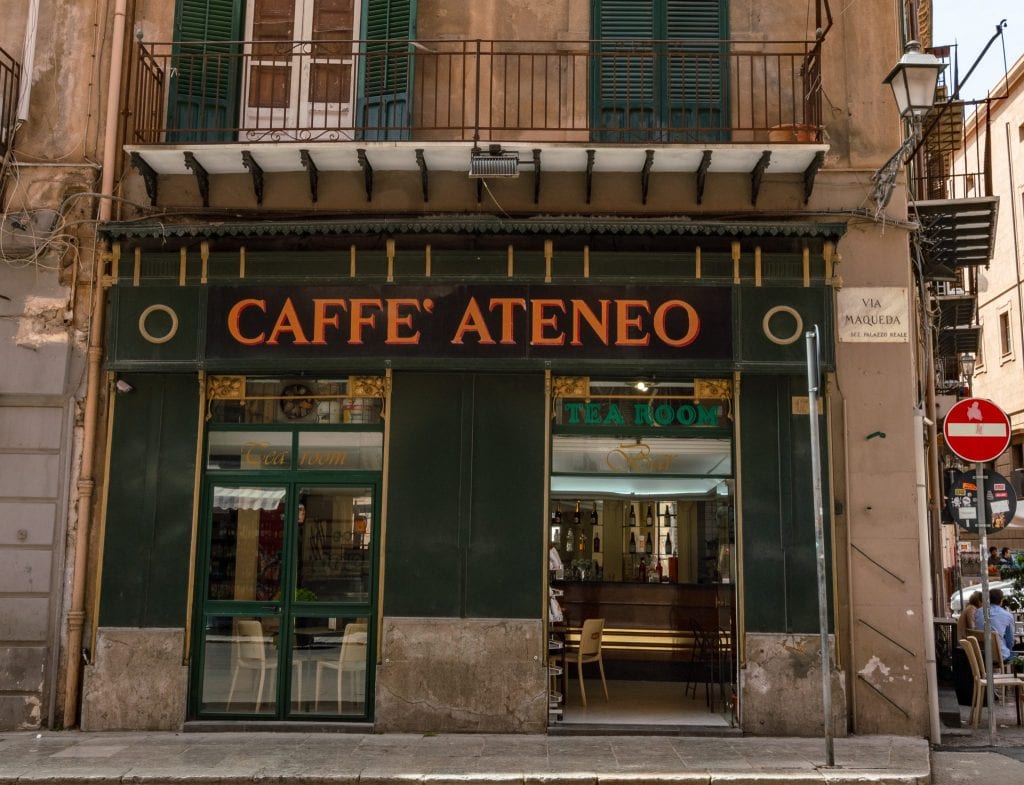
Caldo/Freddo — Hot/Cold
Zucchero — Sugar
If you like sugar in your coffee, you probably won’t need to ask for it!
Either there will be small packs sitting on the bar, or (more often) a large, communal jar of sugar you can take from.
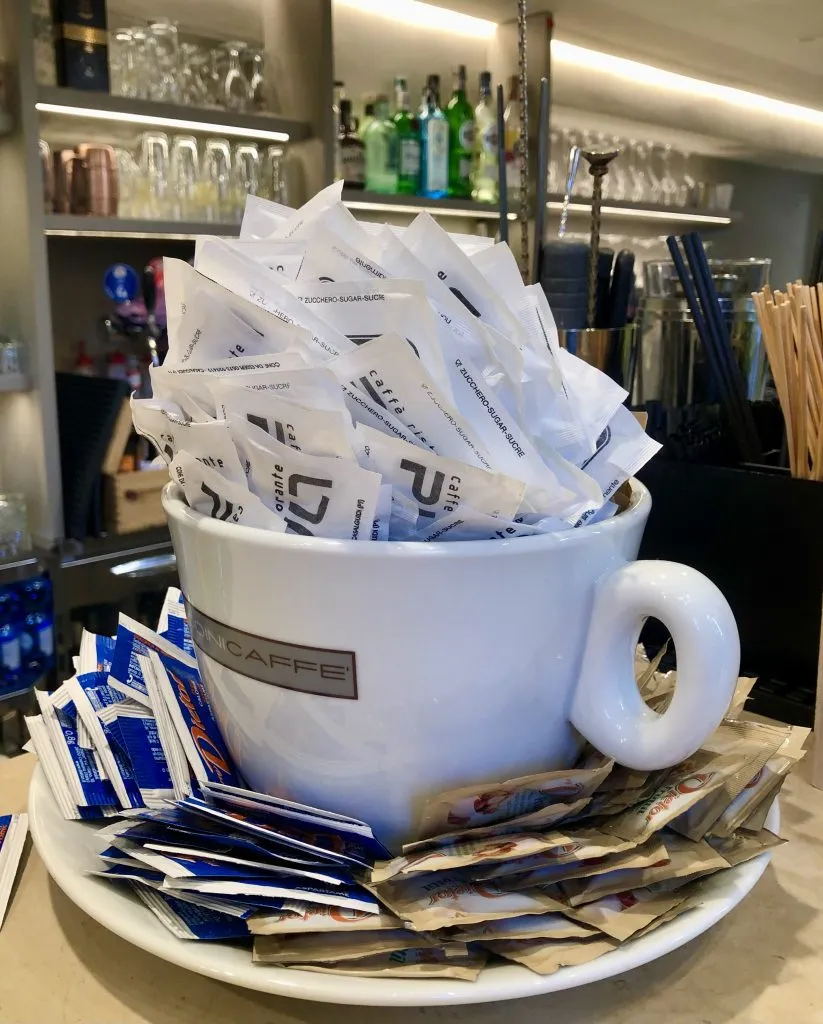
Un Cornetto, Un Brioche — A Pastry
You may also want to know cioccolato (as seen in “un cornetto cioccolato”, or a cornetto stuffed with chocolate–and chocolate usually means Nutella) and crema (a vanilla cream, similar to pudding, also used as a stuffing).
Whether or not you use cornetto or brioche is regional–you’ll generally find brioche in the northern reaches of Italy.
You’ll also often see more specific local pastries available, but these simple options are available across the country!
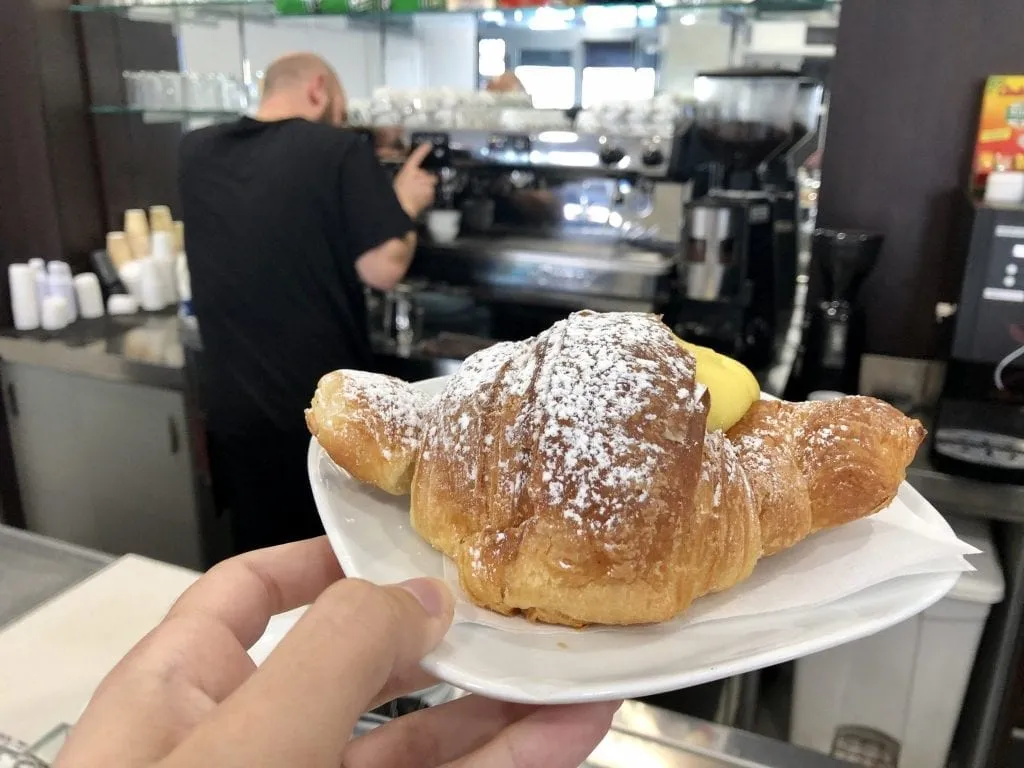
One Euro is a solid going price for a caffè.
That is speaking very, very generally of course, but it’s a good rule of thumb.
It’s fairly easy to find a caffè for .80-.90 Euro off the beaten path, even in major cities, and also easy to pay 1.2 Euro or more near the biggest tourist attractions in Italy.
… but that assumes you do as the locals do and stand at the bar.
In Italy, it’s typical to drink your coffee standing at the bar, leaning against the marble countertop, and using the communal sugar to sweeten it if needed.
If you choose to sit down, expect the price to jump dramatically.
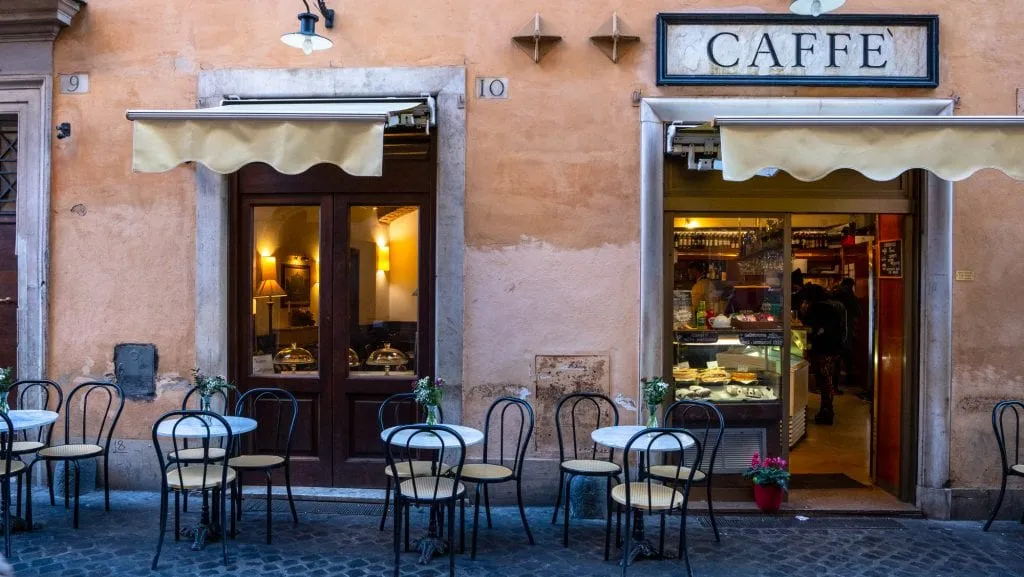
Cash is expected when ordering coffee in Italy.
Some bars accept credit cards for larger transactions, but it’s unlikely that they’ll accept it for a couple of Euro worth of coffee.
Much better to have small bills/coins on hand to pay for it!
You don’t need to tip.
Tipping culture in Italy varies depending on where you are and what you’re doing, but a tip is never expected for coffee at a bar.
If you feel like you received truly exceptional service, you can choose to round up the bill.
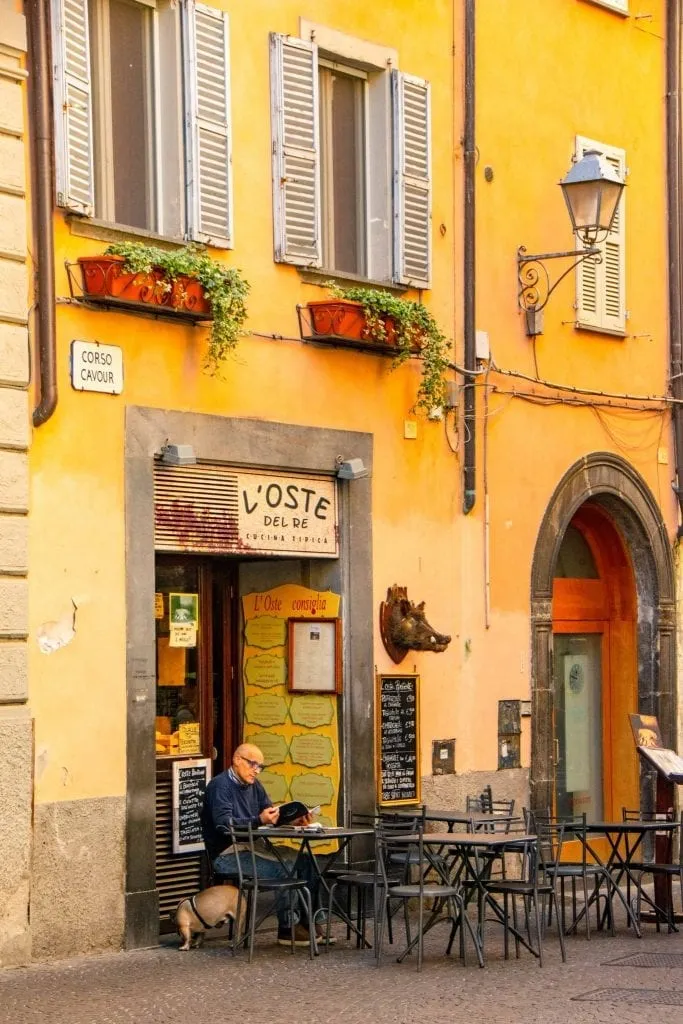
Don’t specify the size of your coffee.
You’re not ordering a small, medium, or large caffè: you’re ordering a caffè, and it will come in a designated caffè cup.
The size of your coffee in Italy is generally dictated by the kind of coffee you order, not the amount you would like.
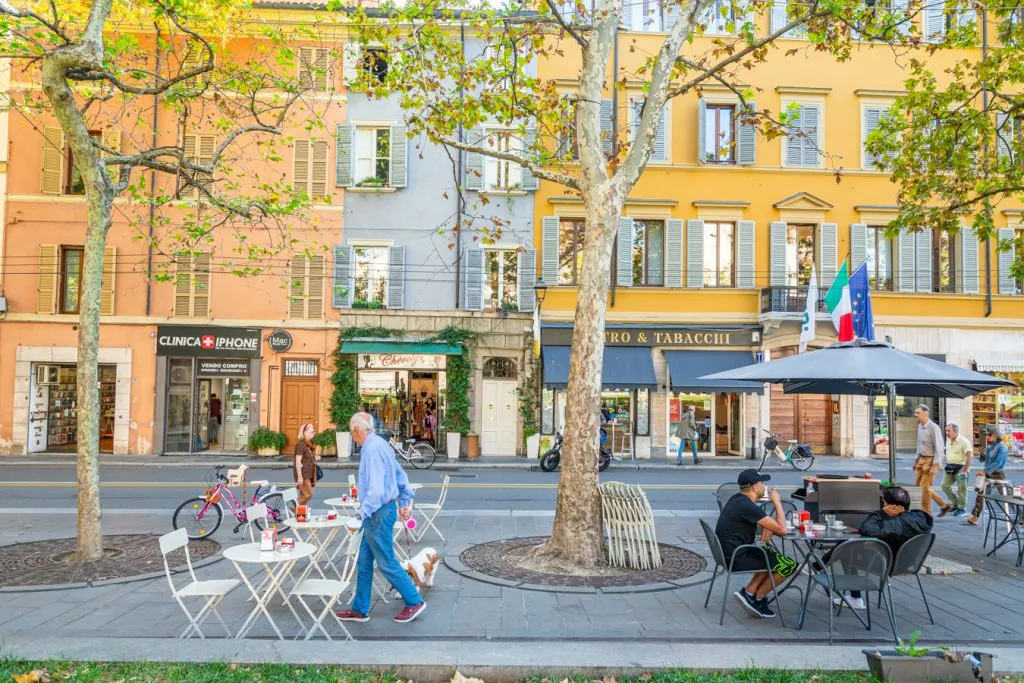
Italian bars must display their menu with prices.
This isn’t always in the most obvious spot, but if you look closely, you’ll always be able to spot a clearly-marked menu hanging somewhere inside the bar.
Most often, this is hanging over the bar or near the register, though you will sometimes find it by the door as well.
Note how the tavolo (table) price on the right side of the menu is much higher than the base price on the left!
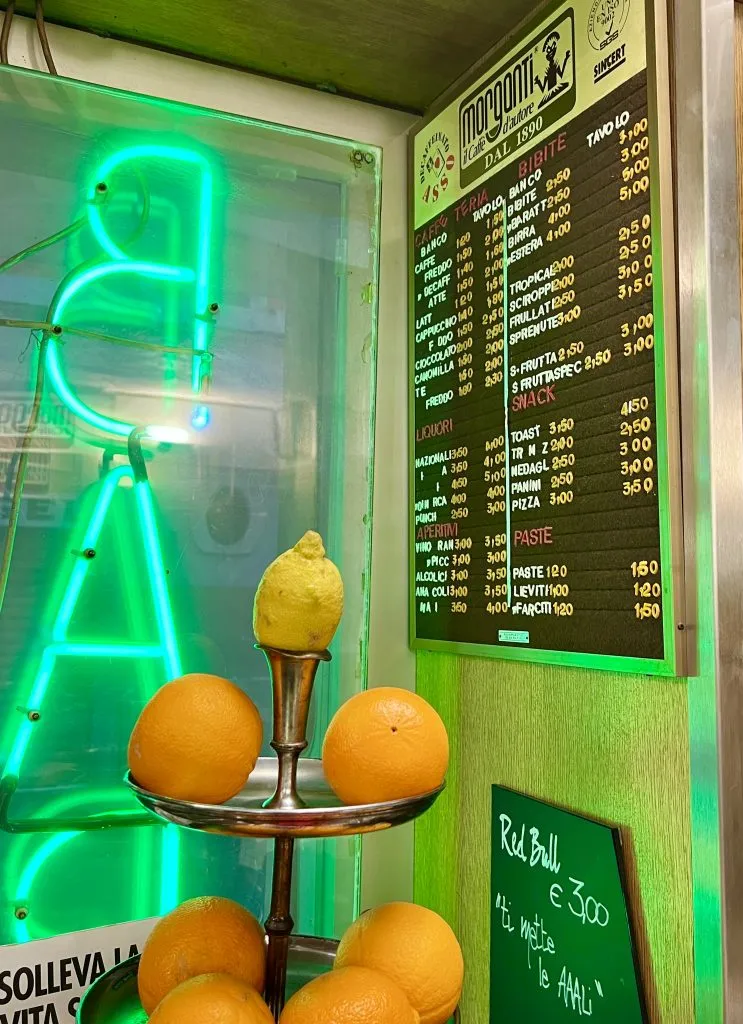
If you’re grabbing a coffee for breakfast, consider picking up a pastry as well.
Italian breakfast consists of coffee and maybe a pastry—especially cornetti, Italy’s answer to croissants, which you’ll most commonly find stuffed with Nutella or cream.
(Though you’ll find a cornetto turns into a brioche when you’re in parts of northern Italy, like Lake Como).
Some bars are also pastry shops that bake their own treats, but most often, a bar will buy a supply of pastries at the beginning of the day, and when they’re gone, they’re gone.
Come early if you’re picky!
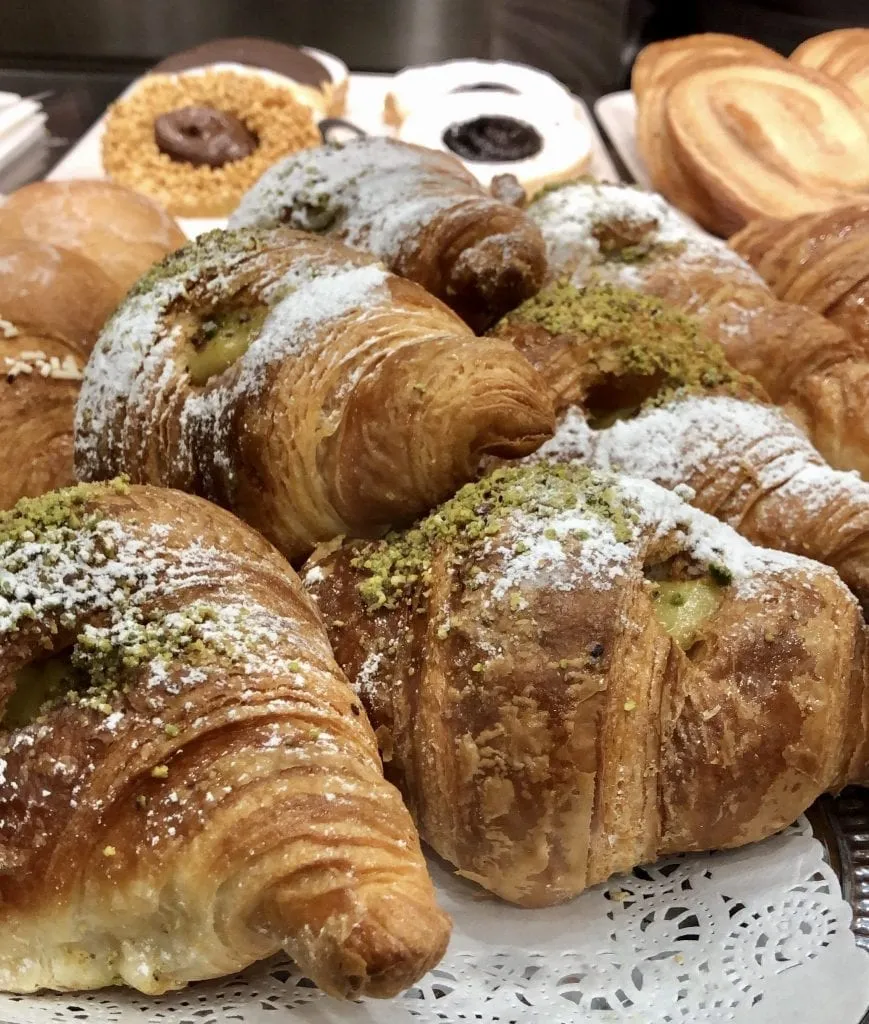
Don’t ask for a cappuccino after around 11:00 AM when ordering coffee in Italy.
Everything about eating in Italy revolves around digestion, and that includes coffee.
You may have heard before that drinking a cappuccino after breakfast is frowned upon in Italy, and that is because milk is considered difficult to digest and is not suited for consumption after a meal like lunch or dinner.
This ties into the Italian breakfast ritual above—in Italy, a cappuccino at breakfast is either a large part of a meal or an entire meal unto itself.
Of course, Italians are used to tourists ordering them at all times of day, and will definitely serve you a cappuccino after dinner and most likely never say a thing about it.
But, if you prefer to do as the Romans do, so to speak, keep this rule in mind when ordering coffee in Italy!
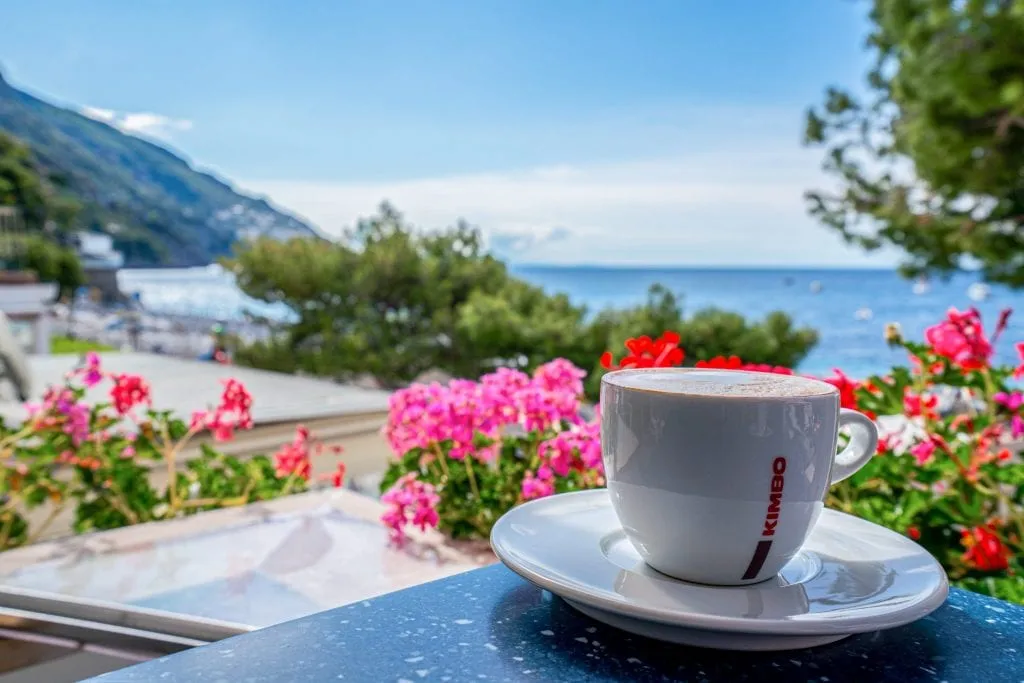
… and definitely don’t ever order a “latte”.
If you’re clearly a tourist, you’ll most likely get a good-natured clarification.
But, if you’re located far off the beaten path or the bartender is feeling particularly sassy, you just might end up with a straight glass of milk!
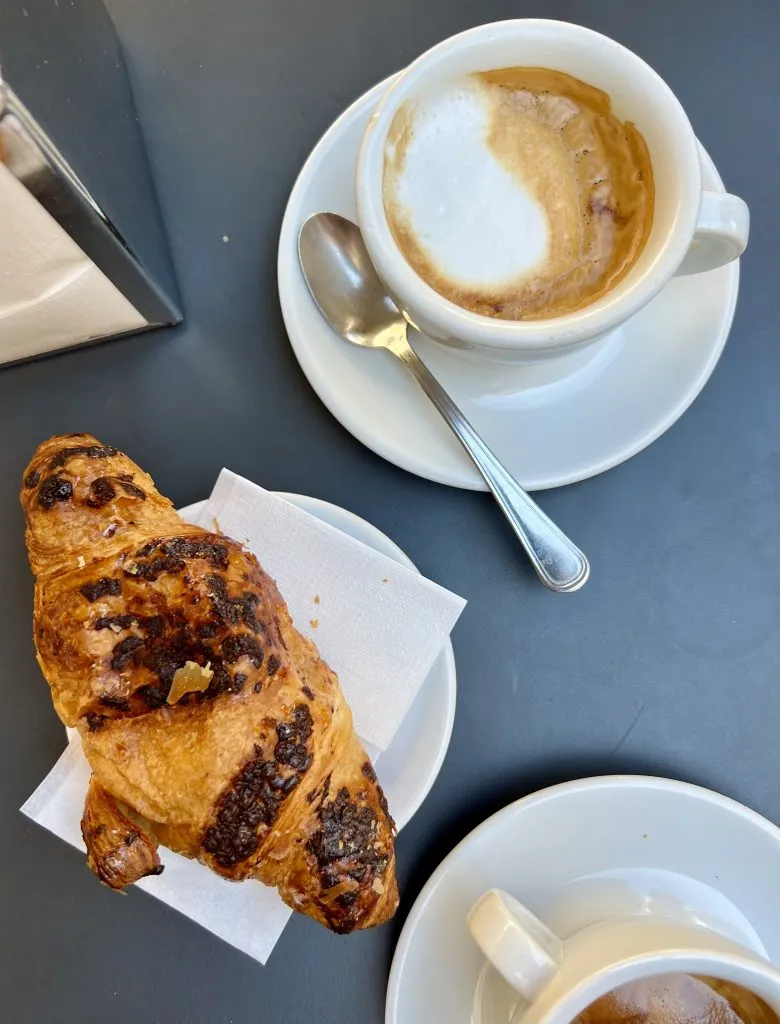
Coffee “to go” isn’t an option.
Coffee in Italy is intended to be drunk at the counter, and unless you’re in an extremely touristy area, there’s approximately a 0% chance of there even being a to-go cup on the premises.
When ordering coffee in Italy, come with the plan to drink it there (it’s more fun that way, anyway).
2022 Update: In a post-2020 world, takeaway/to-go coffee seems to have become a bit more common, especially at roadside bars.
We’ll see how long this new habit sticks around, but we were definitely surprised when it was offered to us a couple of times, and even more so when we saw a clearly local woman order 2 coffees to go this fall.
Italian coffee tastes much better when you drink it immediately, though–better to stick with the original way if you can.
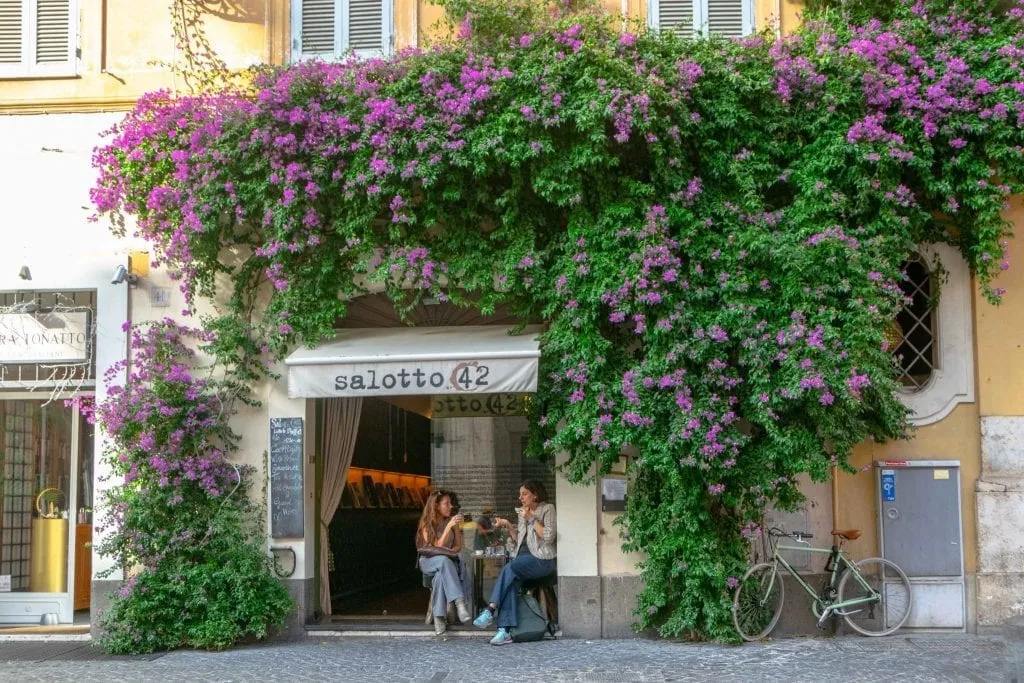
Pay attention to how the locals pay for their coffee.
When researching how to order coffee in Italy, you’ll likely come across two theories on how paying for coffee is handled.
The first (and arguably more “official”) advice is that you pay at the cash register first, hand your ticket to the bartender showing your order, and then they make your coffee.
The second theory is that you order and drink your coffee first and then pay on your way out the door.
We only have our own experience to go on, but after visiting literally hundreds of coffee shops across Italy, we have only ordered coffee the “official” way by paying first maybe 5-10 times, if that.
We also haven’t found it particularly common for locals (especially regulars) to pay in advance either–and believe me, we people-watched very carefully after finding out that we were potentially messing up with our Italian coffee etiquette!
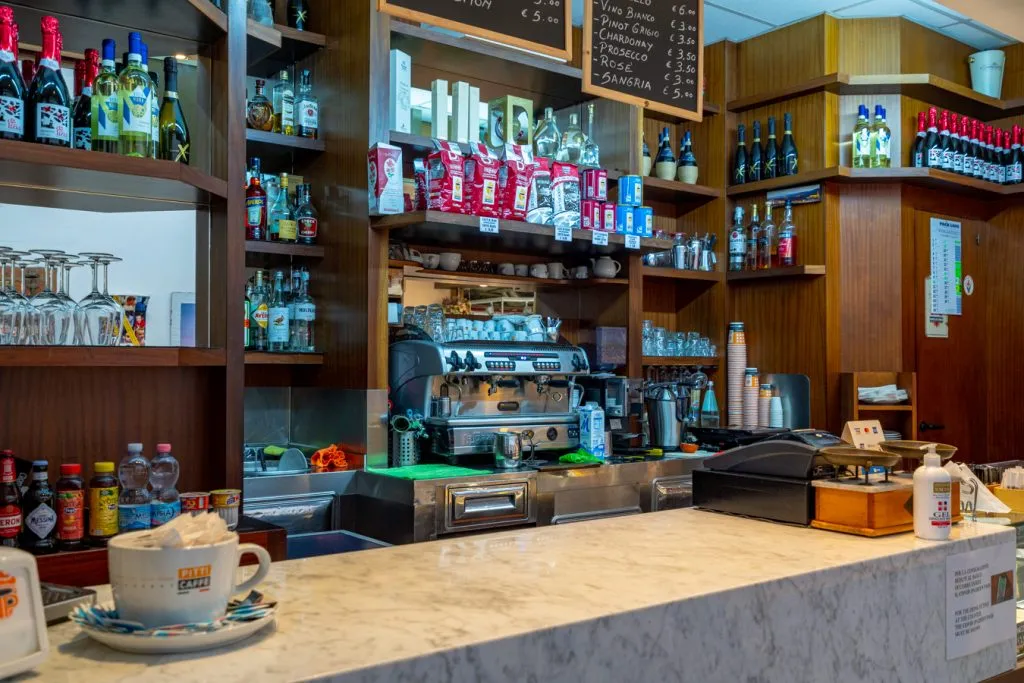
We have found that it is much, much more common to simply order, drink, and then pay.
More often than not, if the coffee shop isn’t particularly crowded, it’s a bit of a moot point anyway because the person pulling the shot and the person manning the register are frequently one and the same.
Our advice?
If the bar is particularly busy, crowded, fancy, or simply bigger than average, hang back for a minute and watch how the locals are handling things–this is when you’ll most likely need to pay in advance.
If the bar is dead or there are only a couple of other customers, just order politely at the bar and follow the bartender’s lead from there.
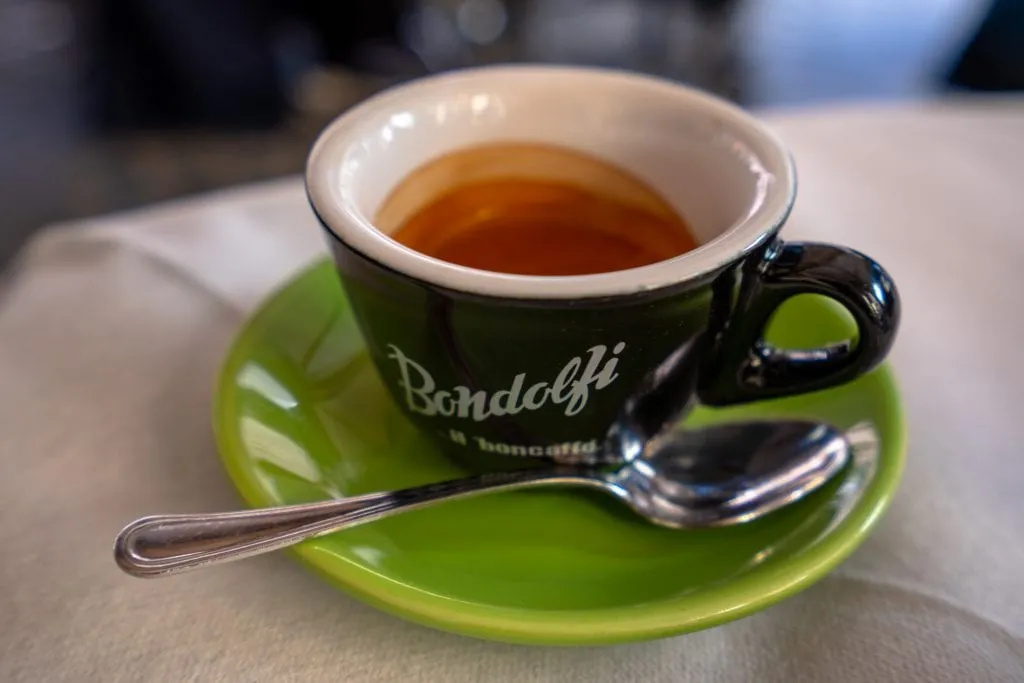
Coffee is the perfect way to end a meal.
In Italy, a quick caffè is considered the perfect way to round off your lunch or dinner—and it’s a delightful and addicting habit to join in on!
Coffee is generally ordered and drunk after dessert, as the absolute final course of the meal (with the exception of maybe a digestif after that, if you’re so inclined).
Often, in a restaurant, your post-meal coffee will come with a small chocolate or cookie as well.
Since these coffees are drunk at the table, they tend to run around 2 Euro instead of one, but the experience is worth the price.
And, if you’re sensitive to caffeine like me, this is the perfect time to order a deca!
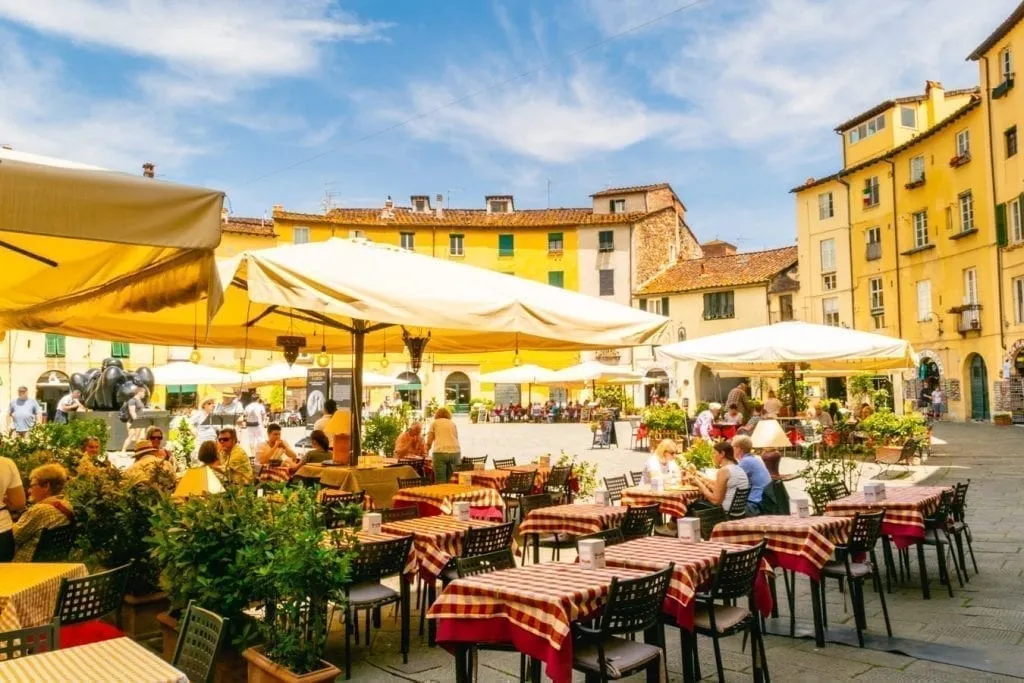
If you find a bar you love, keep coming back!
This is one of our favorite features of coffee culture in Italy!
Even over the course of a week, you can develop a temporary semi-regular status at your bar of choice, get into a comfortable routine of ordering coffee in Italy, and potentially develop a rapport with your bartender(s).
We have spent four months “living” in various cities in Italy (2 months in Rome, one in Florence, one in Bologna), and our first goal each time is to find “our” bar(s) near where we are staying so that we can develop a routine and keep returning again and again.
If you order the same thing each time and come by daily, it probably won’t be long until the bartender memorizes your order!
If you don’t love the first bar you go to, try a few more.
Sometimes it takes a couple of tries to find the right balance of friendliness, cozy vibes, excellent Italian coffee, and pastry selection!
[convertkit form=828904]
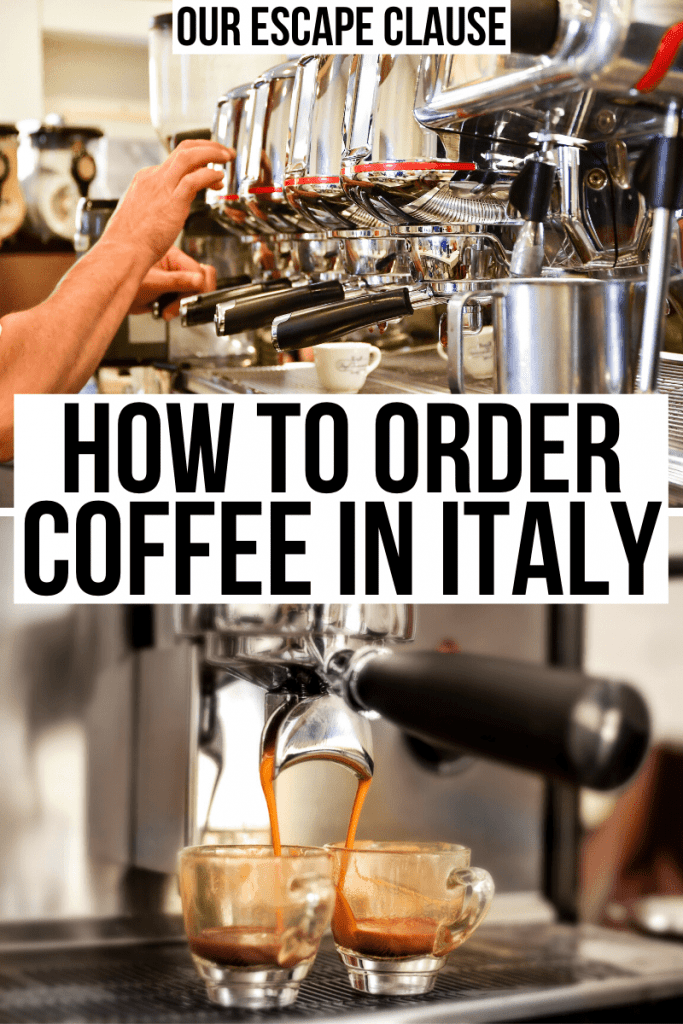
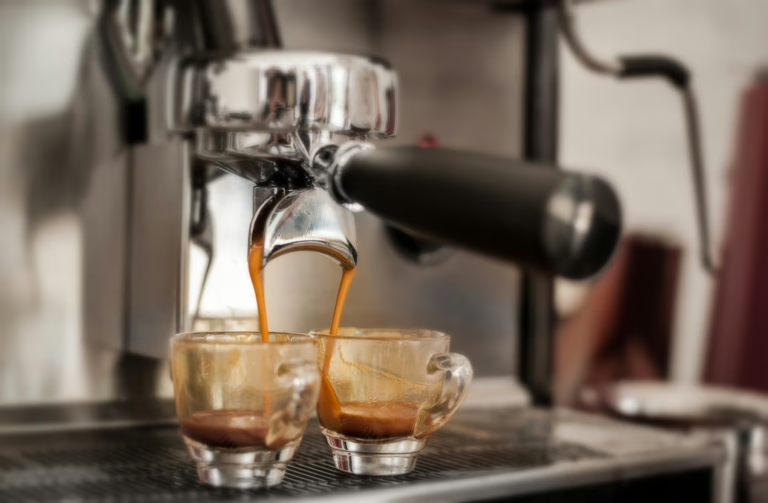
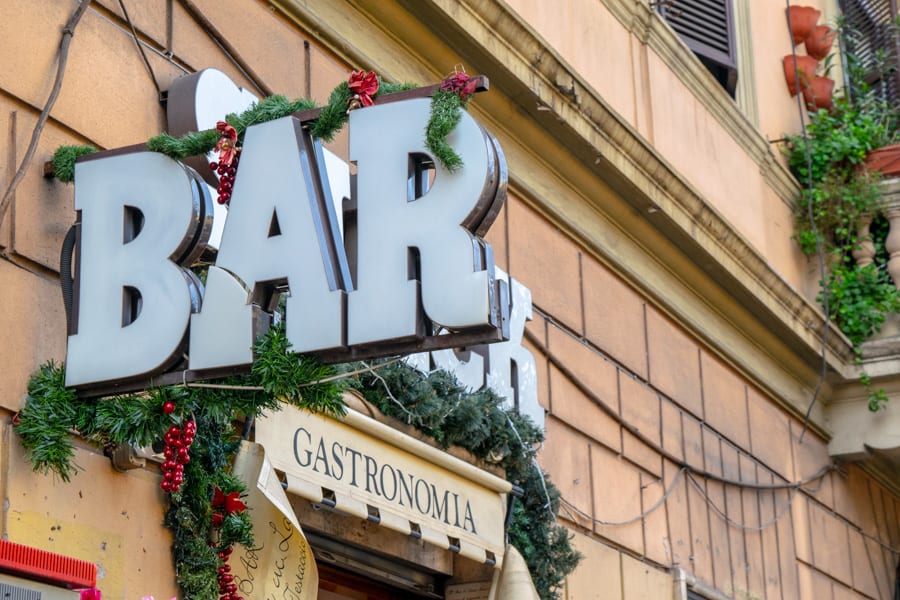
This is a great guide. One question, is there such a thing as a caffe lungo doppio? that sounds like what might work perfectly for me. And yes I will try the straight caffe or a macchiato first. I also am loving your other italy posts. We are headed to Tuscany, Amalfi, Sicily and Rome in May for 3 weeks.
Hi John! Thank you so much–hope you guys have a fantastic 3 weeks in Italy.
As far as the coffee, I’ve never heard of such a thing, but I bet you might find a bar willing to make you one! You could also order a doppio and “cut” it with a little extra water yourself.
Thanks for these tips! I’m looking forward to my first trip to Italy in a couple of months and will be very pleased to be a bit informed!
Hello,
I am planning my first trip to Europe and have found your blog to be unbelievably helpful!
I just had a question about coffee, in Rome but also all over Europe as well, how common is it to ask for an iced coffee? And would I get some looks if I did?
Thank you~
Hi Sammy,
So glad our site has been helpful!
Iced coffee is not really a “thing” in Italy (or Europe overall) the way it is in the USA. It’s actually very commonly cited as something American expats living in Europe miss about home!
There are some exceptions and workarounds, though.
In Italy, you can order a “caffè shakerato” which is espresso shaken up with ice and sugar.
For something simpler, you can order a “caffè con ghiaccio”, which is a shot of espresso served with a separate cup of ice on the side. You then pour the coffee over the ice yourself.
Caffè con ghiaccio comes from the Salento region in Puglia, but you can order it around Italy. Jeremy got really into them this summer and ordered them all over the place. 🙂
Hi! What about my personal favourite: the affogato? I like this after lunch instead of any other form of dessert. A slightly smaller than golf-ball sized ball of vanilla ice cream with a red-hot espresso poured over top. I live in Austria, right on the border with Italy. We find this coffee with ease here. And also in Sicily… I can’t speak for other parts of Italy, particularly.
Affogato is definitely filed under “dessert” instead of “coffee drink” in my brain, though of course, you’re right it could fit here, too! And it is delicious. 🙂
I have a dairy allergy. Do they have almond milk or do you suggest I bring my own?
Hi Lesle,
A few more upscale cafes in places like Rome might, but it’s not ubiquitous by a long shot.
I don’t drink dairy milk either, and honestly, I just trained myself to fall in love with espressos since they don’t have any milk. When in Rome, as they say. Now I’m completely in love with them and can’t imagine disrupting the perfect espresso-plus-cornetto combination with milk (the sweetness of the nutella, jam, or cream in a cornetto cuts the coffee beautifully).
Just my experience, but it might be worth a try if you want to experiment!
This is so very helpful as we are visiting Italy for the first time this Fall. Thank you! One question is, is caffe lungo not as commonly served? Asking because the price chart photo that you posted as an example doesn’t have lungo option.
Hi Emmy!
It’s not as common as ordering a “standard” shot of coffee, but everyone will know exactly what it is.
Generally, it’ll be the same price as a usual caffe–it’s more of a different style than a different drink (like how a medium steak and a rare steak aren’t listed separately on the menu, for example).